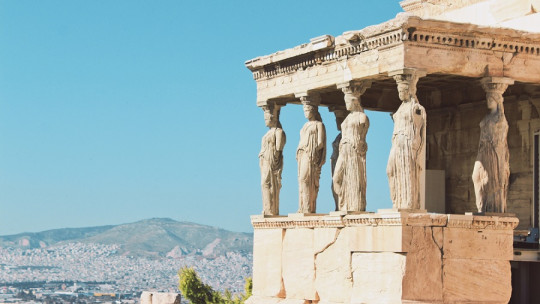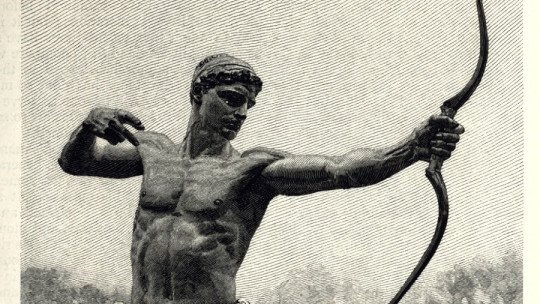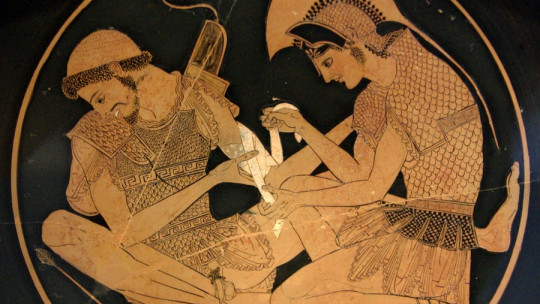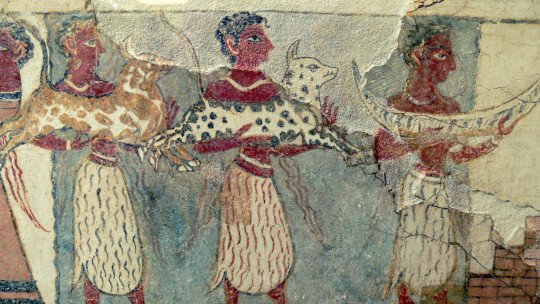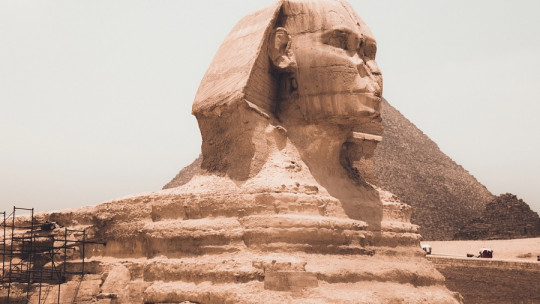
In many sources from Ancient Greece and some from Egypt, Anatolia and nearby territories, a people known as the Achaeans appear, who are credited with having participated in the famous war against Troy, the same one where a wooden horse was used to overthrow it. .
However, although much is said about them in both the Iliad and the Odyssey, it is not clear who they were and exactly where they could be said to have lived.
Who were the Achaeans? Were they a lineage of Greeks? a Balkan ethnic group? An ethnic group from the Peloponnese? Mycenaeans? All of these are questions that many historians have asked themselves based on archaeology, various sources and testimonies from Classical Greece, questions that arise when trying to get to know this people.
Who were the Achaeans?
The Achaeans (from the Latin “Achaei” and this in turn from the Greek “Ἀχαιοί”, “Akhaioí”) is the name they receive different peoples of Classical Antiquity It is one of the collective names used to refer to all the Greeks in the Odyssey and in Homer’s Iliad, along with two other terms to refer to the inhabitants of most of what is now Greece: Danaans and Argives. . In addition to these Greek sources, the Achaeans appear in the Bible, although referred to as Achaians.
But apart from literature, the Achaeans existed or, at least, was the name used to refer to the inhabitants of Achaea, a region located north of the Peloponnese. The city-states of this region formed a confederation called the Achaean League, an alliance that was truly influential between the 3rd and 2nd centuries BC. c.
Originally the Achaeans were an Indo-European people who inhabited the southern Balkans from 2000 BC. C. and which, later, would give rise to the Mycenaean civilization, although in academic historiography it is preferred to refer to them as “Mycenaean” proper. It is believed that this Bronze Age people left the Balkans for Greece around 1800 BC, being one of the first Indo-European settlers to reach this peninsula.
Different kingdoms would be established there, notably those of Mycenae and Tiryns. Later, around 1400 BC, these Achaeans “peacefully” conquered the island of Crete and introduced some innovations, fundamental for the later Greek civilization: the chariot, horses, weapons forged in bronze and greater sumptuousness and protocol in the funeral ceremonies of the nobles.
The Achaeans of the Peloponnese had a social organization that revolved around the family through kinship and they were governed with a political system led by a warrior prince. Among its most important divinities are the goddess Potnia and the god Poseidon, king of the seas.
Myth of the appearance of the Achaeans in Achaia
In Greek mythology Perceived cultural divisions among the classical Greeks were represented as legendary lines of descendants who were identified in kinship groups, each line coming from an ancestor that gave its name to that line. Each Greek “ethnicity” was named in honor of one of its heroic ancestors:
The myth tells that Cadmus of Phenicia, Danaus of Egypt and Pelops of Anatolia made a place for themselves in continental Greece, being assimilated and transformed into Greeks Helen, Graikos, Magnis and Macedonia were children of Deucalion and Pyrrha, who were the only survivors of the great flood. The ethnic group was originally named after the eldest son, the Graikoi of Graikos (the word “Greek” comes from here) but was later renamed after another of his children, Helen, who had proven to be the strongest.
The children of Helen and the nymph Orseis were Dorus, Jutus and Aeolus. The children of Jutus and Creusa, daughter of Erechtheus, were Ion and Achaeus, who was the creator of the Achaean race. When Achaeus’s uncle, Aeolus in Thessaly, died, Achaeus became lord of Phthiotis, which was renamed Achaia.
The Achaeans and the Mycenaeans
Some experts have identified the Achaeans as the Mycenaeans, a culture related to the Greeks and in fact there is evidence that they spoke a very ancient dialect of the Greek language. Others believe that the Achaeans did not enter Greece before the Dorian invasions of the 12th century BC.
As described by Homer, the Achaeans were a people who came from the continental and western islands of Greece such as the island of Crete, Rhodes and other nearby islands, except for the Cyclades islands. It is curious that these islands coincide precisely with those where the Mycenaean culture developed between the 14th and 13th centuries BC according to the current opinion of modern archaeology.
Another reason why it is believed that Mycenaeans and Achaeans must have been the same is the fact that they had precisely the city of Mycenae as the administrative capital of their territories of influence, which was considered that way by colonized peoples such as the Cretans. The influence of the Mycenaeans spread throughout Asia Minor, the Iberian Peninsula and Ancient Egypt
Cultural characteristics of the Achaean-Mycenaeans
Taking the idea that the Achaeans were Mycenaeans, the main cities of this people were Mycenae, their administrative capital, Tiryns, Pylos, Athens, Thebes, Iolcos and Orchomenus, in addition to having settlements in Macedonia, Epirus and some Aegean islands. Based on history and part of the myth, The most renowned feat by the Achaeans would be their 10-year siege of Troy a city that held great military and economic power and that posed a serious threat to Mycenae.
The Achaeans were organized into three social classes, not very different from the rest of the cultures of Greece. The most privileged class was that of the high administrative officials in the palace who exercised political-military power; Below them were the citizens, the only ones who were required to pay taxes but who had some rights; and that of slaves, who were used exclusively in palaces and religious buildings.
The Achaean-Mycenaeans buried their nobles with all kinds of treasures and seated them in curious hexagonal-shaped tombs, distributed like a honeycomb The burial of the warrior class was more humble, simply taking the weapons and armor they had used in life. However, those who had been war heroes were cremated and their ashes were placed in urns that were decorated with bright and beautiful gold masks.
Because the era of splendor of the Mycenaean culture and that of the Minoan culture coincided in the same century, historians believe that both ethnic groups were involved in some conflict that would lead to the subsequent disappearance of the Achaeans, although this is also the subject of debate. What is known is that After the fall of Mycenae due to the action of the Dorians, the survivors dispersed across several Greek islands and they also reached the Anatolian peninsula, present-day Türkiye.
Where does its name come from?
Today Greeks refer to themselves as “Hellenes” and, in fact, the official name of their country, modern Greece, is the Hellenic Republic. Modern Hellenes share common traits and identity that define them as a fairly homogeneous nation most of them having Greek as their mother tongue in addition to a rich gastronomy, customs and traditions, shared by their ancestors and that have survived the Turkish influence to which they were subjected for so many centuries.
However, this idea of a single nation has not always existed. In classical antiquity, Greek culture was divided into a group of city-states and its inhabitants, although aware of being similar, did not have an idea of a united nation or ethnic group as we understand it today. Thus, to refer to themselves they used different names such as Ionians, Dorians, Aeolians and also Achaeans, designating with these words the inhabitants of the different territories of classical Greek civilization.
Nevertheless, The idea that “Achaeans” was used as a synonym for the Greeks of the time is controversial There are testimonies that would indicate that more than another name used to call the group of Greeks as Homer did, it must have been its own culture, a people who happened to live in the lands of modern-day Greece and who shared Greek traits but were not exactly that. In fact, there are documents from other civilizations that give some strength to this hypothesis.
The Hittites
The Hittites were a people who settled mostly on the Anatolian peninsula, in a country they called Hatti. In some of their texts it is mentioned that to the west there was a nation called Ahhiyawa A letter is the first document in which this country is mentioned, which summarizes the violations of the treaty of the Hittite vassal Madduwatta who is also called Ahhiya.
Another important document is the Tawagalawa letter, written by a king whose historiography has not been able to find out who he was but who must have lived between the 14th and 13th centuries BC. C. The letter was addressed to the king of Ahhiyawa, treating him as an equal and suggesting that Miletus, called Milawata in Hittite, was under his control. It also refers to an earlier Wilusa episode, which involved hostilities on the part of Ahhiyawa.
This Ahhiya has been identified with the Achaeans of the Trojan War and Wilusa would be the name with which the Hittites referred to the city of Troy In fact, there is some similarity between the names of the acropolis of Troy, Wilion (Ϝιλιον), later Ilion (Ίλιον) and the Hittite name of Wilusa.
Likewise, this remains an open debate since, beyond the phonetic similarities between the Hittite term Ahhiyawa and Greek Akhaioi (pronounced /ajéi/), there is still no completely conclusive evidence, even after it has been discovered that the Mycenaean Linear B It was actually an ancient form of Greek and, therefore, the Mycenaeans spoke this language, being able to be classified as Greeks linguistically speaking.
The Egyptians
Another civilization that apparently established contact with these Akkadians was the Egyptian one During the fifth year of the reign of Pharaoh Merenptah, the existence of a confederation of peoples from Libya and the north who attacked the western Delta is mentioned in several sources. Among the ethnic names of the invaders is that of “Ekwesh” which, according to some historians, would have been neither more nor less than the Achaeans themselves.
In fact, Homer mentions an attack by the Achaeans in the Egyptian Delta. Herodotus, another great classical thinker, states in his first book that Helen had been taken to Egypt during the Trojan War and that, afterward, the Greeks went to the African nation to recover her.
The Achaean League
We cannot finish talking about the Achaeans without mentioning one of the most important political alliances of Classical Greece. The Achaean League (Greek “τὸ Ἀχαϊκόν”, “tò Achaïkón”) was a confederation of cities in the region of Achaia At its peak the League controlled the entire Peloponnese peninsula, except for the southern region of Laconia. This sociopolitical alliance would come to an end with Roman rule over Greek lands, leading to its dissolution in 146 BC after the Achaean War.
The existence of this league is quite long. A first existed in the 5th century BC, the result of the union of four cities and it barely intervened in armed conflicts during this century. Later, in the time of Herodotus (484-425 BC), the league was already a little more extensive and consisted of twelve city-states: Aegyra, Aegae, Helice, Ripes, Bura, Aegio, Pelene, Patras, Pharas, Dime, Olenus and Tritera. Ripes and Egas disappeared practically immediately, being replaced by Cerinea and Leontio. It is not known what the relations between these cities were and it was surely a religious league rather than a political one.
In principle The Achaean League had the city of Helice as its headquarters and Poseidon as its tutelary god (like a patron saint) However, when this city was destroyed by a tsunami in 373 BC, the headquarters was transferred to Aigio and devotion to the god of the seas was lost, being replaced by Zeus and Demeter as new tutelary gods.
In 338 BC during the Battle of Chaeronea the league fought alongside Athens and Thebes, but was defeated by the Macedonians. After that she was very weakened, so much so that she could not even take advantage of the advantageous event that was the death of Alexander the Great and the beginning of the Lamiacan War. In fact, it was so weak that it couldn’t hold out much longer and ended up dissolving. Demtrio Poliorcetes and Cassander of Macedon imposed garrisons on the cities and the cities ended up being politically separated.
Summary
The Achaeans arouse a lot of mystery in historiography because it is not very well known what they were As we have seen, some consider that it was one of the many names that were used to refer to the Greeks as a whole, while others attribute a purely literary existence to it and others believe that Achaeans and Mycenaeans were synonymous terms and others only see it as something “Achaean” the name given to the political-religious league established in the north of the Peloponnese
Be that as it may, their name went down in history and much has been written about their possible origin, their cultural traits, what they believed in, what great historical events they participated in and whether or not they were really the same as the Mycenaeans. The debate is still open and this further fans the flames of curiosity and the desire to know more about the true Achaeans.

